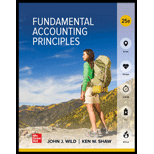
Sub Part-1
Bonds Issuance:
The Bonds issuance by the company is a source of long term financing and is issued at a discount or premium depending the prevailing market rate of interest and stated rate of interest on bonds. When the stated rate of interest is lower than the market rate of interest, then the investors will be ready to invest only in the situation when the bonds are issued at discount. This discount on bonds issue shall be treated as expenses of the issuing company and need to be amortized over a period of bonds.
The total amount of discount on bonds issuance.
Sub Part-3
Effective Interest Method of Amortization of discount:
The Effective Interest method of amortization of discount is a technique of writing off the total discount over a period of bonds by computing the discount amortized in each period after deducting the cash interest paid in each period at stated rate from the interest expenses of each period at market rate of interest.
Amortization table:
The amortization table under
The Amortization table shall be prepared.
Want to see the full answer?
Check out a sample textbook solution
Chapter 14 Solutions
FUND.ACCT.PRIN.(LOOSELEAF)
- Accurate answerarrow_forwardCan you help me solve this general accounting problem using the correct accounting process?arrow_forwardSullivan Manufacturing estimates that overhead costs for the next year will be $3,200,000 for indirect labor and $480,000 for factory utilities. The company uses machine hours as its overhead allocation base. If 160,000 machine hours are planned for the next year, what is the company's plantwide overhead rate? HELParrow_forward
- During 2019, Driscoll Company earned revenues of $175,000, had expenses of $128,000, purchased assets with a cost of $22,000, and paid dividends of $12,500. What was the net income for the year?arrow_forwardNeed answerarrow_forwardI am looking for a step-by-step explanation of this financial accounting problem with correct standards.arrow_forward
- Calculate the direct labor rate variance of the above information.arrow_forwardDepartment B had 12,000 units in work in process that were 75% completed as to labor and overhead at the beginning of the period; 52,400 units of direct materials were added during the period; 48,000 units were completed during the period, and 9,500 units were 60% completed as to labor and overhead at the end of the period. All materials are added at the beginning of the process. The first-in, first-out method is used to cost inventories. The number of equivalent units of production for conversion costs for the period was ____ Units.arrow_forwardPlease provide the solution to this general accounting question with accurate financial calculations.arrow_forward

 AccountingAccountingISBN:9781337272094Author:WARREN, Carl S., Reeve, James M., Duchac, Jonathan E.Publisher:Cengage Learning,
AccountingAccountingISBN:9781337272094Author:WARREN, Carl S., Reeve, James M., Duchac, Jonathan E.Publisher:Cengage Learning, Accounting Information SystemsAccountingISBN:9781337619202Author:Hall, James A.Publisher:Cengage Learning,
Accounting Information SystemsAccountingISBN:9781337619202Author:Hall, James A.Publisher:Cengage Learning, Horngren's Cost Accounting: A Managerial Emphasis...AccountingISBN:9780134475585Author:Srikant M. Datar, Madhav V. RajanPublisher:PEARSON
Horngren's Cost Accounting: A Managerial Emphasis...AccountingISBN:9780134475585Author:Srikant M. Datar, Madhav V. RajanPublisher:PEARSON Intermediate AccountingAccountingISBN:9781259722660Author:J. David Spiceland, Mark W. Nelson, Wayne M ThomasPublisher:McGraw-Hill Education
Intermediate AccountingAccountingISBN:9781259722660Author:J. David Spiceland, Mark W. Nelson, Wayne M ThomasPublisher:McGraw-Hill Education Financial and Managerial AccountingAccountingISBN:9781259726705Author:John J Wild, Ken W. Shaw, Barbara Chiappetta Fundamental Accounting PrinciplesPublisher:McGraw-Hill Education
Financial and Managerial AccountingAccountingISBN:9781259726705Author:John J Wild, Ken W. Shaw, Barbara Chiappetta Fundamental Accounting PrinciplesPublisher:McGraw-Hill Education





